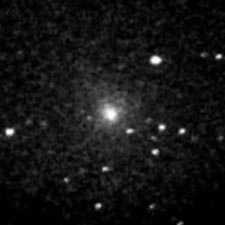
P. Clay Sherrod of Arkansas Sky Observatory captured this CCD image of Comet Hoenig early on Tuesday morning, July 30th. He used a 12-inch Meade Schmidt-Cassegrain telescope at f/3.75. Note the suggestion of a short, fanned tail toward upper left.
A comet first seen by a German amateur astronomer in July, then lost for five days, is about to become an easy target for small telescopes in the Northern Hemisphere. The nearly tailless object looks like a fuzzy, 10th-magnitude star, slowly making its way from Andromeda into Cassiopeia. It should brighten to 9th magnitude by mid-August as it enters the north circumpolar sky, then remain this bright through September while turning south across Ursa Major.
It was shortly after midnight on July 22nd that Sebastian Hoenig of Dossenheim, Germany, found himself unable to sleep. So he got up, loaded his Meade 10-inch telescope into the car, and drove to his favorite observing site in the Odenwald woods near Heidelberg. He soon stumbled upon a fuzzy glow just north of the Great Square of Pegasus, in a region he knew to be almost devoid of galaxies and other deep-sky objects. But Hoenig had no star atlas with him — not even a scrap of paper for making notes — so he rummaged through the car and turned up an empty water bottle! Its small white label was just large enough for him to make a careful sketch of the star field. He kept the object in view long enough to determine that it was moving slowly to the north, at about 3 arcminutes per hour.
Later that day Hoenig e-mailed the discovery details to the Central Bureau of Astronomical Telegrams (CBAT) in Cambridge, Massachusetts. But neither he nor any other observer could locate the object again, owing to a very bright Moon and the object's uncertain location. Finally on July 27th, Ken-ichi Kadota in Saitama, Japan, captured a CCD image of the comet 8° north of Hoenig's initial position, thus confirming the discovery.
Calculations by Gareth V. Williams (Smithsonian Astrophysical Observatory), announced July 30th on IAU Circular 7941, indicate that Comet Hoenig will reach perihelion (its closest point to the Sun) around October 1st. It will then be situated between the orbits of Venus and the Earth, traveling in a near-parabolic orbit inclined 73 ° to the plane of the ecliptic. The ephemeris below gives the comet's right ascension and declination (equinox 2000.0) at 0 hours Universal Time for the next few days, its predicted magnitude, and the constellation though which it is passing.
With this find, Hoenig becomes the first amateur astronomer to discover a comet from German soil since 1946. But he's no stranger to comets; he is also credited with locating 20 comets in SOHO spacecraft images of the Sun's vicinity.
| Comet Hoenig, C/2002 O4 | ||||
| Date (0h UT) | R.A.(h, m) | Dec. (° ') | Magnitude | Constellation |
| Aug 2 | 23 09.4 | +51 13 | 10 | And |
| Aug 3 | 23 05.8 | +53 21 | 10 | Cas |
| Aug 4 | 23 01.7 | +55 30 | 9.9 | Cas |
| Aug 5 | 22 57.0 | +57 40 | 9.8 | Cep |
| Aug 6 | 22 51.5 | +59 52 | 9.8 | Cep |
| Aug 7 | 22 45.1 | +62 03 | 9.7 | Cep |
| Aug 8 | 22 37.6 | +64 15 | 9.6 | Cep |
| Aug 9 | 22 28.6 | +66 24 | 9.6 | Cep |
| Aug 10 | 22 17.9 | +68 32 | 9.5 | Cep |
 0
0
Comments
You must be logged in to post a comment.